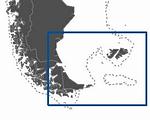 阿根廷政府日前下令該國南端外海136哩一座海底島嶼的周邊海域為禁漁區。這片位於南大西洋的海域,即是眾所周知的「柏伍德岸堤區」(Burdwood Bank),為一範圍涵蓋694平方哩的保護區,其中蘊藏著世界上獨有而豐富的各種硬珊瑚和軟珊瑚品種。
阿根廷政府日前下令該國南端外海136哩一座海底島嶼的周邊海域為禁漁區。這片位於南大西洋的海域,即是眾所周知的「柏伍德岸堤區」(Burdwood Bank),為一範圍涵蓋694平方哩的保護區,其中蘊藏著世界上獨有而豐富的各種硬珊瑚和軟珊瑚品種。
柏伍德岸堤區是飼育鯨魚、海獅、企鵝、信天翁的重要攝餌場,同時也是生態上的二大重要魚類──南藍鱈(southern blue whiting)和火地島沙丁魚(Fuegian sardines)的繁殖區。此區的頂層掠食者和遷移物種都是從遙遠的南極、南喬治亞島(英屬福克蘭群島以東1300公里處)、以及紐西蘭過來的。
總部位於紐約的野生動物保育協會(Wildlife Conservation Society)在其「海洋及天空計畫」底下,也指定柏伍德岸堤區是一個重要的野生物棲地。所謂「海洋及天空計畫」,主要工作是針對南半球最廣袤、也最多產區域之一的「巴塔哥尼亞陸棚大型海洋生態系統」(Patagonian Shelf Large Marine Ecosystem),推動預警式經營管理機制。
9 月26日,阿根廷漁業部長卡洛斯切比(Carlos Cheppi)執行阿根廷國家漁業委員會(Federal Fisheries Council)的指令,永久禁止該區包括底拖網漁業(bottom trawling)在內的所有漁業活動,底拖網漁業是一種工業化的捕魚方式,在海底使用並拖曳大型笨重的魚網進行捕魚活動。
 雖然這種底拖漁網能夠捕獲目標魚類,但它同時也造成珊瑚、海綿、和其他動物的死亡。目前已知這種捕魚法將嚴重破壞海底生態系統的產卵場和生態儲存場。
雖然這種底拖漁網能夠捕獲目標魚類,但它同時也造成珊瑚、海綿、和其他動物的死亡。目前已知這種捕魚法將嚴重破壞海底生態系統的產卵場和生態儲存場。
參與「海洋及天空計畫」的坎巴格納博士(Dr. Claudio Campagna)表示,「藉由健全的科學方法來保護柏伍德岸堤區,國家漁業委員會已經在確保阿根廷漁業產業之永續經營方面踏出了一大步。」
野生動物保育協會從1970年代即開始參與該區的保育活動,而且活動範圍包括研究、訓練、教育、以及政策研究等。
The government of Argentina has banned commercial fishing along an underwater island submerged in the South Atlantic Ocean 136 miles off the long country's southern tip.
Known as Burdwood Bank, the protected area encompasses 694 square miles rich in hard and soft coral species found nowhere else on Earth.
Burdwood Bank serves as an important feeding ground for whales, sea lions, penguins, and albatross. It is also the breeding ground for two ecologically important fish species - southern blue whiting and Fuegian sardines.
The community of top predators and migratory species in this area come from as far away as Antarctica, South Georgia Island, and New Zealand.
The New York-based Wildlife Conservation Society has identified Burdwood Bank as a critical wildlife area under its Sea and Sky initiative, which seeks to promote precautionary management of the vast Patagonian Shelf Large Marine Ecosystem, one of the most productive regions in the southern hemisphere.
On September 26, Argentine Fisheries Secretary Carlos Cheppi implemented a Federal Fisheries Council mandate, which permanently banned all fishing activities in the area including bottom trawling - an industrial fishing method that employs large, heavy nets dragged across the seabed.
While the method captures the desired target fish, it also kills corals, sponges, and other animals. The method is known to be destructive of underwater ecosystems that serve as spawning grounds and ecological storehouses.
"Armed with sound science, Consejo Federal Pesquero has taken a big step in ensuring sustainability in Argentina's fishing industry by protecting Burdwood Bank," said Dr. Claudio Campagna, of the Wildlife Conservation Society's Sea and Sky Program.
The Wildlife Conservation Society's involvement in the region dates back to the 1970s and has included research, training, education, and policy development.
全文及圖片詳見:ENS




